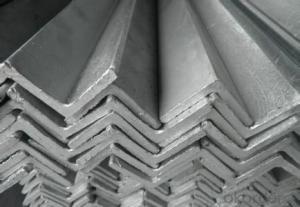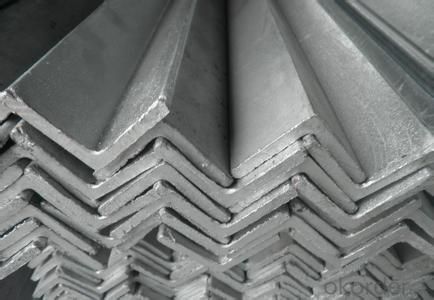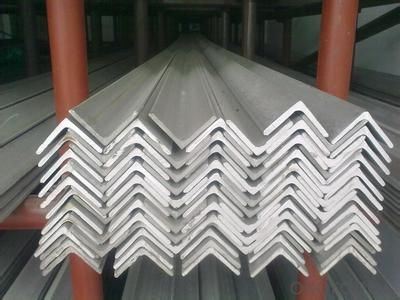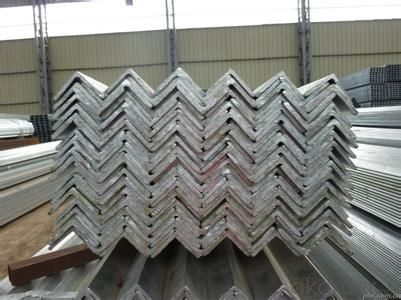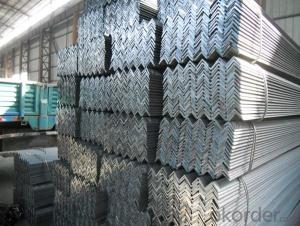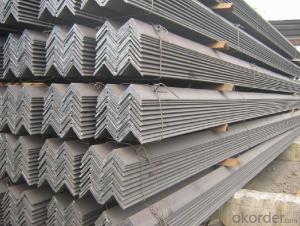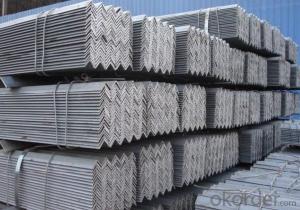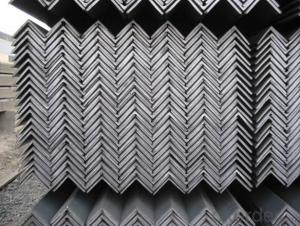high quality unequal angle ASTM A36
- Loading Port:
- China Main Port
- Payment Terms:
- TT OR LC
- Min Order Qty:
- -
- Supply Capability:
- -
OKorder Service Pledge
OKorder Financial Service
You Might Also Like
Product Description:
Stainless Steel Angles
1.Grade: SS200,300,400 series
2.Size: 25×25×3 mm-100×100×10mm
3.Process: HRAP
4. Length: 2-6m
5. Shape: Equal
6. Delivery: within 20 days
7. MOQ: 1 ton
8. Certificate: ISO 9001:2008, SGS
9. Package:Standard Export Packing, or put into wooden boxes according to your
requirement
10. Application: Construction, Marine, Industry and so on
Name | Stainless Steel Angles | ||||||
Standard | ASTM A554, A312, A249, A269 and A270 | ||||||
Material Grade | 304,316,201,202, 316L,430 | ||||||
Length | 6m or as customers' request | ||||||
Tolerance | a) thickness: +/-0. 15mm | ||||||
| |||||||
b) Length:+/-4. 5mm - 0mm | |||||||
Surface | 180G, 320G, 400G Satin / Hairline(Matt Finish, Brush, Dull Finish) 400G, 500G, 600G or 800G Mirror finish | ||||||
Application | Decoration construction, upholstery, industry instruments | ||||||
Test | Squash test, Extended test, Water pressure test, Crystal rot test, Heat treatment, NDT | ||||||
Chemical Composition of Material |
Composition
Material | 201 | 202 | 304 | 316L | 430 | |
C | ≤0.15 | ≤0.15 | ≤0.08 | ≤0.08 | ≤0.12 | ||
Si | ≤1.00 | ≤1.00 | ≤1.00 | ≤1.00 | ≤1.00 | ||
Mn | 5.5-7.5 | 7.5-10 | ≤2.00 | ≤2.00 | ≤1.00 | ||
P | ≤0.06 | ≤0.06 | ≤0.045 | ≤0.045 | ≤0.040 | ||
S | ≤0.03 | ≤0.03 | ≤0.030 | ≤0.030 | ≤0.030 | ||
Cr | 16-18 | 17-19 | 18-20 | 16-18 | 16-18 | ||
Ni | 3.5-5.5 | 4-6 | 8-10.5 | 10-14 |
| ||
Mo |
|
|
| 2.0-3.0 |
| ||
Mechanical Property | Material Item | 201 | 202 | 304 | 316L | ||
Tensile Strength | ≥535 | ≥520 | ≥520 | ≥520 | |||
Yield Strength | ≥245 | ≥205 | ≥205 | ≥205 | |||
Extension | ≥30% | ≥30% | ≥35% | ≥35% | |||
Hardness (HV) | <253 | <253 | <200 | <200 | |||
- Q: Can steel angles be used for acoustic isolation or noise barriers?
- Steel angles can be used for acoustic isolation or noise barriers, although they may not be as effective as other materials specifically designed for this purpose. Steel angles can help to reduce noise transmission to some extent by reflecting and absorbing sound waves. However, their effectiveness depends on various factors such as the thickness and density of the steel, as well as the overall design and construction of the barrier. Additionally, steel angles are not typically designed to have soundproofing properties, so using them alone may not provide optimal acoustic isolation. It is recommended to consider specialized materials and techniques specifically designed for noise barriers to achieve the best results.
- Q: What are the load-bearing capacities of different sizes and types of steel angles?
- The load-bearing capacities of steel angles can differ depending on various factors, including the type of steel, size of the angle, and the specific application. Steel angles are commonly used in construction and engineering projects to provide structural support and stability. The load-bearing capacity of a steel angle is primarily determined by its cross-sectional area, which is influenced by the angle's size and thickness. Generally, larger and thicker steel angles have higher load-bearing capacities compared to smaller and thinner ones. The American Institute of Steel Construction (AISC) offers guidelines and tables that specify the allowable loads for different steel angles based on their dimensions and the type of steel used. These tables take into account factors such as the angle's shape, length, and the direction of the load. It's important to note that load-bearing capacities can also be affected by the specific type of steel used in the angle. Different types of steel, like carbon steel, stainless steel, or alloy steel, have varying mechanical properties that impact their load-bearing capabilities. For instance, stainless steel angles typically have higher load-bearing capacities and better resistance to corrosion compared to carbon steel angles. To determine the specific load-bearing capacities of steel angles of different sizes and types for a particular application, it is recommended to consult engineering handbooks, structural design codes, or seek advice from a professional engineer. These resources offer detailed information and calculations based on industry standards to ensure the safe and efficient use of steel angles in structural designs.
- Q: Can steel angles be used in the construction of government buildings?
- Government buildings can indeed utilize steel angles for construction purposes. The strength and durability of steel angles make them a prevalent choice in building construction. Their ability to provide stability and support to the overall structure deems them appropriate for government buildings, which require sturdy and long-lasting construction materials. Furthermore, the versatility of steel angles allows for easy fabrication and customization, meeting the specific design requirements of various architectural and structural applications within government buildings.
- Q: What are the different grades of steel used for manufacturing steel angles?
- There are several different grades of steel that are commonly used for manufacturing steel angles. These include: 1. Mild Steel: This is the most common grade of steel used for manufacturing steel angles. It has a low carbon content and is relatively inexpensive. Mild steel angles are suitable for a wide range of applications and have good weldability and formability. 2. High-strength low-alloy (HSLA) steel: This grade of steel contains small amounts of alloying elements such as copper, vanadium, or niobium, which enhance its strength and toughness. HSLA steel angles are commonly used in structural applications where high strength and durability are required. 3. Stainless Steel: Stainless steel angles are manufactured using alloys that contain a high percentage of chromium, which provides excellent corrosion resistance. These angles are commonly used in environments where corrosion is a concern, such as coastal areas or chemical plants. 4. Carbon Steel: Carbon steel angles are made from a combination of iron and carbon, with carbon content typically ranging from 0.05% to 2.1%. The higher the carbon content, the stronger and harder the steel. Carbon steel angles are commonly used in construction and machinery manufacturing. 5. Alloy Steel: Alloy steel angles are made by adding various alloying elements such as manganese, nickel, chromium, or molybdenum to carbon steel. These additions improve the strength, hardness, and resistance to wear and corrosion of the steel. Alloy steel angles are commonly used in heavy-duty applications such as mining equipment or industrial machinery. The choice of grade of steel for manufacturing steel angles depends on the specific requirements of the application, including the desired strength, durability, corrosion resistance, and cost.
- Q: What are the different finishes available for steel angles?
- There are several different finishes available for steel angles, including hot-dip galvanized, mill finish, painted, and powder coated.
- Q: Can steel angles be used for stair treads?
- Yes, steel angles can be used for stair treads. Steel angles provide structural support and stability, making them a suitable choice for stair treads. They can be easily installed and offer durability and resistance to wear and tear, making them ideal for high-traffic areas such as stairs.
- Q: Are steel angles resistant to termites and pests?
- No, steel angles are not susceptible to termite and pest infestations as they are made of inorganic materials.
- Q: How many meters is one angle steel?
- Angle called angle, the steel strip is perpendicular to each other on both sides into the corner. There are equal angles and unequal angles. The two sides of an equal angle steel are equal in width. The specifications are expressed in millimeters of edge width * edge width * edge thickness. Such as "/ 30 x 30 x 3", that is 30 mm width equal angle, edge thickness of 3 mm. Also available models that model is the number of centimeters wide, such as angle 3#. The model does not mean the size of the different edges and sizes of the same model. Therefore, the width, the edge and the thickness of the angle iron should be filled out in the contract and other documents, so as not to be indicated by the model alone.
- Q: Can steel angles be used for manufacturing furniture?
- Yes, steel angles can be used for manufacturing furniture. They provide structural support and can be used to create strong and durable furniture pieces. Steel angles are commonly used in industrial and modern furniture designs due to their sleek and minimalist aesthetic.
- Q: What are the considerations for selecting the appropriate steel angle thickness?
- There are several considerations for selecting the appropriate steel angle thickness. Firstly, the load-bearing capacity of the steel angle must be taken into account. The thickness should be chosen based on the expected weight and stress that will be placed on the angle. Additionally, the length and span of the angle should be considered, as longer and wider spans may require thicker steel angles to provide adequate support. Environmental factors, such as exposure to corrosive substances or extreme temperatures, should also be evaluated to select a thickness that can withstand these conditions. Finally, budget constraints and cost-effectiveness may influence the choice of steel angle thickness, as thicker angles are generally more expensive.
Send your message to us
high quality unequal angle ASTM A36
- Loading Port:
- China Main Port
- Payment Terms:
- TT OR LC
- Min Order Qty:
- -
- Supply Capability:
- -
OKorder Service Pledge
OKorder Financial Service
Similar products
Hot products
Hot Searches
Related keywords
